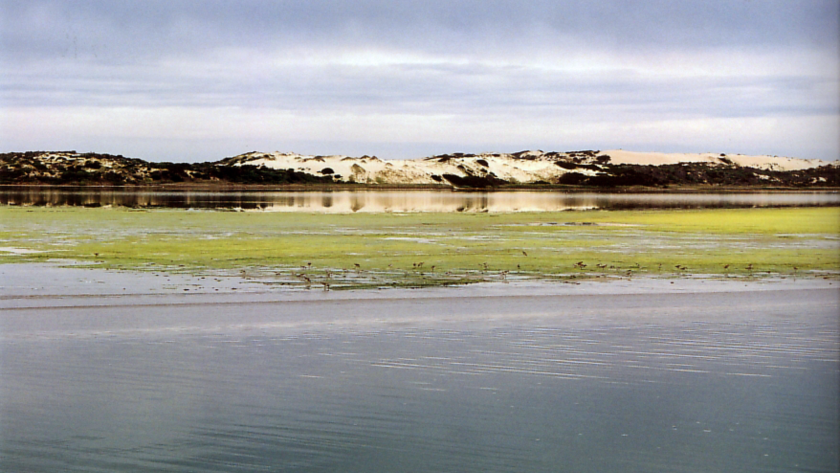
South Australia’s Algal Bloom Crisis: What Can Communities Do?
Over the past months, South Australia has faced a marine disaster of unprecedented scale: a harmful algal bloom (HAB) sweeping across hundreds of kilometres of coastline, killing thousands of marine animals, and disrupting communities, industries, and ecosystems. How we respond now will shape the resilience and future of our coastal regions.
What’s happening:
Scale and species
- The bloom is dominated by the dinoflagellate Karenia mikimotoi, though related algal species are also present.
- It’s affecting coastal regions from the Fleurieu Peninsula, Kangaroo Island, Yorke Peninsula, Spencer Gulf, parts of Gulf St Vincent, and metropolitan Adelaide beaches.
- Citizen scientists have documented over 12,000 observations of marine mortalities affecting more than 400 species.
Causes: the “perfect storm”
The algal bloom is not a simple phenomenon. Rather, it arises from multiple stressors aligning:
- Marine heatwave / abnormally warm sea temperatures: waters are about 2.5 °C warmer than typical for this period.
- Calm sea conditions / low wind / low mixing: lack of turbulence means algal layers remain concentrated.
- Nutrient enrichment: runoff from floods, river discharges, and possibly coastal agricultural inputs provide extra nitrogen and phosphorus to fuel algal growth.
- Upwellings and organic matter: upwelling brings deeper, nutrient-rich water upward; decomposing marine organisms also release additional nutrients.
- Climate change as multiplier: higher baseline temperatures, changing rainfall patterns, stronger extreme weather events, and warmer conditions make HABs more frequent and severe.
In short: the bloom is symptomatic of deeper shifts in our marine-climate systems.
Impacts: Ecological, Social, Economic
Ecological damage
- Massive mortalities across fish, sharks, rays, invertebrates, sea dragons, cuttlefish, and others.
- Localised collapse or damage in benthic communities, seagrass beds, kelp forests, and reef systems (though long-term monitoring is still underway).
- Disruption of food webs and ecosystem services: loss of habitat, reduction of predators and prey, and long-term stress on regeneration.
- The Coorong, a Ramsar-listed wetland and key ecological zone, is under threat of “ecological collapse” due to spillover and habitat stress.
Public health & community stress
- Coastal visitors and locals report irritated eyes and throats, as well as respiratory discomfort, especially near foamy or discoloured water.
- Health authorities warn that those with asthma or respiratory conditions may be more vulnerable.
- Mental health burdens are rising: coastal communities express anxiety, grief over lost marine life, fear of long-term damage, and uncertainty.
Economic disruption
- Tourism businesses (hotels, cafes, tour operators) are reporting significant losses. A survey found impacted businesses lost on average ~$52,000 in a month, with some losing over $100,000.
- Seafood, aquaculture, and fishing sectors face closures, halts in harvesting, and disrupted supply chains.
- Community clean-ups (removing dead marine life) are placing heavy burdens on local councils and volunteers.
- Events have been cancelled (e.g. open water swims) and recreation sectors may shrink.
What is being done: response, support, and gaps
Government‐led responses & funding
- A $102.5 million support plan has been announced by South Australian and Australian governments to assist research, clean-up, industry support, and community recovery.
- Hotlines and a dedicated algal bloom website provide ongoing updates, health guidance, and mechanisms to report wildlife deaths.
- Community forums are being organized across the state to share scientific updates, hear local voices, and coordinate efforts.
- Some experimental mitigation: e.g. a bubble curtain has been trialed near the cuttlefish breeding grounds in Spencer Gulf to block bloom intrusion.
- Increased surf lifesaving patrols, beach monitoring, and public safety communications are planned for the summer season.
- A Senate inquiry has been initiated to review causes, impacts, and government coordination.
Scientific monitoring & research
- Frequent water sampling, satellite remote sensing for chlorophyll A concentration, ocean current modelling (IMOS), and forecast systems are being used to map bloom distribution and progression.
- The Biodiversity Council has published a “Key Actions” document stressing the urgency of structural reforms and stronger environmental safeguards.
- Conservation Council SA has joined a Harmful Algal Bloom Reference Group to ensure nature-based recovery is central to decision-making.
Gaps and challenges
- Many considered mitigation strategies (e.g. chemical treatments, clay dispersal and physical barriers) are controversial or potentially ecologically harmful.
- Long-term ecosystem recovery (seagrass, reefs, benthic communities) requires years of monitoring and restoration, which is resource-intensive.
- Coordination across levels of government, agencies, scientists, First Nations custodians, communities, and industries is complex and evolving.
- The root drivers (climate change, nutrient management, land-use policies) remain less addressed in many response plans.
A call to action & next steps
This algal bloom is both tragedy and warning: it reveals how vulnerable our coastal systems are, how interconnected land and sea are, and how climate pressures amplify ecological risk. Out of the devastation, our communities have an opportunity to lead with courage, innovation, and collaboration.
Ideas you can action in your local coastal community groups:
- Host a local “Algal Bloom Response Summit” in your town or region, bringing together scientists, local government, coastal residents, fishers, and youth.
- Launch a community monitoring program (water testing kits, training, data-sharing).
- Work to map and prioritise local restoration opportunities (seagrass sites, oyster reef potential, riparian buffer zones).
- Draft a “Coastal Resilience Charter” that includes climate, nutrient, and ecosystem safeguards; present it to local councils.
- Advocate: Submit proposals to state and federal bodies, join reference groups or advisory committees, and ensure community needs are heard.
Feature Image: Wikimedia Commons | CSIRO


